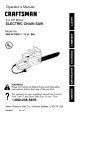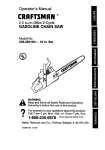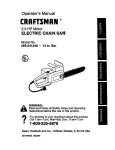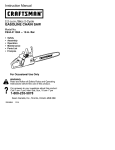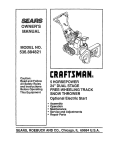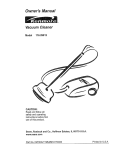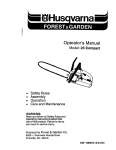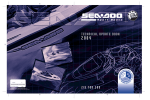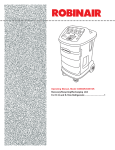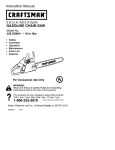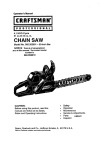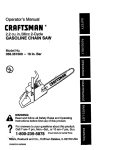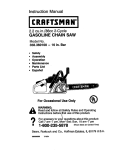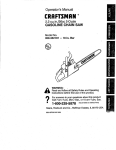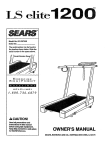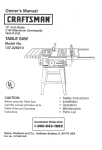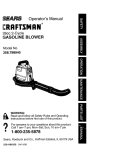Download Husqvarna 128RJ Trimmer User Manual
Transcript
Husqvarna
Operator's Manual
_
Instruction Manual
136 / 141
Read and follow all Safety Rules and Operating
Instructionsbefore
usingthis product. Failureto
do so can result in serious injury.
530088541
4/24/01
1
2
3
10
_23
1.
2.
3.
4.
5.
6.
7.
8.
9.
10.
11.
12.
24
Cylinder Cover
Front Handle
Front Hand Guard
Starter Cover
Chain Oil Tank
Starter Handle
CarburetorAdjusting
Screw
Choke Control
Rear Handle
ON/OFF Stop Switch
Fuel Tank
Muffler
13.
14.
15.
16.
17.
18.
9
21
Bar Tip Sprocket
Saw Chain
Saw Bar
Chain Catcher
Chain Brake Assembly
Rear Hand Guard
19. Throttle Control/Trigger
20. Throttle Lock
21. Bar/Chain Adjustment Tool
22. Chain Tensioning Screw
23. nstruction Manual
24. Guide Bar Cover
WARNING!
This chain saw can be dangerous!
use can cause serious or even fatal injury.
Careless or improper
m
Read and understand
the instruction
manual before using the chain saw.
/
Measured maximum kickback valuewithout
chain combination on the label.
chain brake for the bar and
There may be more symbols found on your unit other than those listed above. These
symbols may represent compliances, standards, or other matters concerning the product.
2
• Carefullyplan your sawing operationin advance. Donor startcuttinguntilyou
havea
clearwork area, secure footing, and, if you
are felling trees, a planned retreat path.
OPERATE
YOUR SAW SAFELY
• Do not operatea chain saw with one hand.
Serious injury to the operator, helpers, bystanders or any combination of these persons may result from one-handed operation. A chain saw is intended for
two-handed use.
• Operatethe chain saw only in a well-ventilated outdoor area.
• Do not operate saw from a ladder or in a
tree.
• Make sure the chain will not make contact
with any object while starting the engine.
Never try to start the saw when the guide
bar is in a cut.
• Do not put pressure on the saw at the end
of the cut. Applying pressure can cause
you to lose control when the cut is completed.
• Stop the engine before setting the saw
down.
• Do not operate a chain saw that is damaged, improperly adjusted, or not completely and securely assembled. Always
replace bar, chain, hand guard, or chain
brake immediately if it becomes damaged,
broken or is otherwise removed.
• With the engine stopped, hand carry the
chain saw with the muffler away from your
body, and the guide bar and chain to the
rear, preferably covered with a scabbard.
MAINTAIN
YOUR
SAW
IN GOOD
WORKING
ORDER
• Have all chain saw service performed by a
qualified service dealer with the exception
of the items listed in the maintenance sectionofthis manual. Forexample, if improper tools are used to remove or hold the flywheel when servicing the clutch, structural
damage to the flywheel can occur and
cause the flywheel to burst.
• Make certainthe saw chain stops moving
when the throttle trigger is released. For
correction, refer to CARBURETOR ADJUSTMENTS.
• Never modify your saw in any way.
• Keep the handles dry, clean, and free of oil
or fuel mixture.
• With the engine stopped, hand carry the
chain saw with the muffler away from your
body, and the guide bar and chain to the
rear, preferably covered with a guide bar
cover.
• Keep fuel and oil caps, screws, and fasteners securely tightened.
• Use only Husqvarna accessories and replacement parts as recommended.
HANDLE
FUEL WITH CAUTION
• Do not smoke while handling fuel or while
operating the saw.
• Eliminateall sources of sparks or flame in
the areas where fuel is mixed or poured.
_WARNING:
Always disconnect
spark plug wire and place wire where it cannot contact spark plug to prevent accidental
starting when setting up, transporting, adjusting or making repairs except carburetor
adjustments.
Because a chain saw is a high-speed woodcutting tool, special safety precautions must
be observed to reduce the risk of accidents.
Careless or improper use of this tool can
cause serious injury.
PLAN AHEAD
• Read this manual carefully until you completely understand and can follow all safety rules, precautions, and operating instructions before attempting to use the
unit.
• Restrict the use of your saw to adult users
who understand and can follow safety
rules, precautions, and operating instructions found in this manual.
Hearing
Safety Hat
Protection
"_l
Snug
Fitting "'",_,/
Clothing
_
#-
Safety
Shoes
_
_
Eye
Protection
Heavy Duty
Gloves
Safety Chaps
• Wear protective gear. Always use steeltoed safety footwear with non-slip soles;
snug-fitting clothing; heavy-duty, non-slip
gloves; eye protection such as non-fogging, vented goggles or face screen; an
approved safety hard hat; and sou nd barriers (ear plugs or mufflers) to protect your
hearing. Regular users should havehearing checked regularly as chain saw noise
can damage hearing. Secure hair above
shoulder length.
• Keep all parts of your body away from the
chain when the engine is running.
• Keep children, bystanders, and animals a
minimum of 30 feet (10 meters) away from
the work area. Do not allow other people
or animals to be near the chain saw when
starting or operating the chain saw.
• Do not handle or operate a chain saw
when you are fatigued, ill, or upset, or if you
have taken alcohol, drugs, or medication.
You must be in good physical condition
and mentally alert. Chain saw work is
strenuous. If you have any conditionthat
might be aggravated by strenuous work,
check with your doctor before operating a
chain saw.
3
Thereshould
benosmoking,
openflames,
orworkthatcouldcausesparks.AIIowengineto coolbeforerefueling.
• Mix andpourfuelin an outdoorareaon
bareground;storefuelina cool,dry,well
ventilatedplace;and use an approved,
markedcontainerfor all fuel purposes.
Wipeupallfuelspillsbeforestartingsaw.
• Moveatleast10feet(3meters)fromfuelingsitebeforestartingengine.
• Turnthe engineoff andlet sawcoolin a
non-combustible
area,notondry leaves,
straw,paper,etc. Slowlyremovefuelcap
andrefuelunit.
• Storetheunitandfuelinanareawherefuel
vaporscannot reach sparks or open
flamesfromwaterheaters,electricmotors
orswitches,furnaces,etc.
KICKBACK
ack Path
Avoid
Clear The Working
Obstructions
Area
REDUCE THE CHANCE
OF
KICKBACK
• Recognize that kickback can happen.
With a basic understanding of kickback,
you can reduce the element of surprise
which contributes to accidents.
• Never let the moving chain contact any object at the tip of the guide bar.
• Keep the working area free from obstructions such as othertrees, branches, rocks,
fences, stumps, etc. Eliminate or avoid
any obstruction that your saw chain could
hit while you are cutting. When cutting a
branch, do not let the guide bar contact
branch or other objects around it.
• Keep your saw chain sharp and properly
tensioned. A loose or dull chain can increase the chance of kickback occurring.
Follow manufacturer's chain sharpening
and maintenanceinstructions.
Checktension at regular intervals with the engine
stopped, never with the engine running.
Make sure the bar clamp nuts are securely
tightened after tensioning the chain.
• Beginandcontinuecuttingatfullspeed.
If
the chain is moving at a slower speed,
there is greaterchance of kickback occurring.
• Cut one log at a time.
• Use extreme caution when re-entering a
previous cut.
• Do not attempt cuts starting with the tip of
the bar (plunge cuts).
• Watch for shifting logs or other forces that
could close a cut and pinch or fall into
chain.
• Use the Reduced-Kickback
Guide Bar
and Low-Kickback
Chain specified for
your saw.
MAINTAIN
CONTROL
a_WARNIN_:
Avoidkickbackwhich
canresultinseriousinjury.Kickbackis the
backward, upward orsudden forward motion
of the guide bar occurring when the saw
chain near the upper tip of the guide bar contacts any object such as a log or branch, or
when the wood closes in and pinches the
saw chain in the cut. Contacting a foreign object in the wood can also result in loss of
chain saw control.
• RotationalKickbackcanoccurwhenthe
moving chain contacts an object at the upper tip of the guide bar. This contact can
cause the chain to dig into the object,
which stops the chain for an instant. The
result is a lightning fast, reverse reaction
which kicks the guide bar up and back toward the operator.
• Pinch-Kickbackcan
occur when the the
wood closes in and pinches the moving
saw chain in the cut along the top of the
guide bar and the saw chain is suddenly
stopped. This sudden stopping of the
chain results in a reversal of the chain
force used to cut wood and causes the
sawto move in the oppositedirectionofthe
chain rotation. The saw is driven straight
back toward the operator.
• Pull-In can occur when the moving chain
contacts a foreign object in the wood in the
cut along the bottom of the guide bar and
the saw chain is suddenly stopped. This
sudden stopping pulls the saw forward and
away from the operator and could easily
cause the operator to lose control of the
saw.
Avoid Pinch-Kickback:
• Be extremely aware of situations or obstructions that can cause material to pinch
the top of or otherwise stop the chain.
• Do not cut more than one log at a time.
• Do not twist the saw as the bar is withdrawn from an undercut when bucking.
Avoid Pull-In:
• Always begincuttingwiththeengineatfull
speed and the saw housing against wood.
• Use wedges made of plastic or wood.
Never use metal to hold the cut open.
Stand to the left of_
the saw
Never reverse
hand positions
4
Symmetrical Guide Bar
{
I
t
Elbow locked
• Low-Kickback
Chain, designed with a
contoured depth gauge and guard link
which deflect kickback force and allow
wood to gradually ride into the cutter.
Low-Kickback
Chain has met kickback
performance requirements when tested
on a representative sample of chain saws
below 3.8 cubic inch displacement specified in ANSI B175.1.
• Keep a good, firm grip on the saw with both
hands when the engine is running and
don't let go. A firm grip will help you reduce
kickback and maintain control of the saw.
Keep the fingers of your left hand encircling and your left thumb under the front
handlebar.
Keep your right hand completely around the rear handle whether
your are right handed or left handed. Keep
your left arm straight with the elbow
locked.
• Position your left hand on the front handlebar so it is in a straight line with your right
hand on the rear handle when making
bucking cuts. Never reverse right and left
hand positions for any type of cutting.
• Standwith your weight evenly balancedon
both feet.
• Stand slightly to the left side of the saw to
keep your body from being in a direct line
with the cutting chain.
• Do not overreach. You could be drawn or
thrown off balance and lose control of the
saw.
• Do not cut above shoulderheight. It is difficult to maintain control of saw above
shoulder height.
SAFETY
Low-Kickback
_.____
Chain
Contoured Depth Gauge
Deflects Kickback
Force And Allows
Elongated
Guard Link
Wood To Gradually
Ride Into Cutter
• Front Hand Guard, designed to reduce the
chance of your left hand contacting the
chain if your hand slips offthefront handlebar.
• Position of front and rear handlebars, designed with distance between handlesand
"in-line" with each other. The spread and
"in-line" position of the hands provided by
this design work together to give balance
and resistance in controlling the pivot of
the saw back toward the operator if kickback occurs.
CHAIN BRAKE AND CKA ANGLE
• Chain Brake, designedto stop the chain in
the event of kickback.
_I_WARNING:
WE DO NOT REPRESENT AND YOU SHOULD NOT AS-
FEATURES
_I_WARNING:
The following features
are included on your saw to help reduce the
hazard of kickback; however, such features
will not totally eliminate this dangerous reaction. As a chain saw user, do not rely only on
safety devices. You must follow all safety
precautions, instructions, and maintenance
in this manual to help avoid kickback and
other forces which can result in serious
injury.
• Reduced-Kickback
Guide Bar, designed
with a small radius tip which reduces the
size of the kickback danger zone on the
bar tip. A Reduced-Kickback
Guide Bar
has been demonstrated to significantly reduce the number and seriousness of kickbacks when tested in accordance with
safety requirements for gasoline powered
chain saws as set by ANSI B175.1.
SUME THAT THE CHAIN BRAKE WILL
PROTECT YOU IN THE EVENT OF A
KICKBACK. Kickback is a lightningfast action which throws the bar and rotating chain
back and up toward the operator. Kickback
can be caused by allowing contact of the bar
tip in the danger zone with any hard object.
Kickbackcan also be caused by pinchingthe
saw chain alongthetop ofthe guidebar. This
action may push the guide bar rapidly back
toward the operator. Either of these events
may cause you to lose control of the saw
which could result in serious injury or even
death. DO NOT RELY UPON ANY OF THE
DEVICES BUILT INTO YOUR SAW. YOU
SHOULD USE THE SAW PROPERLY AND
CAREFULLY TO AVOID KICKBACK.
Reduced-kickback
guide bars and low-kickback saw chains reduce the chance and
magnitude of kickback and are recommended. Your saw has a low kickback chain
and bar as original equipment. Repairs on a
chain brake should be made by an authorized servicing dealer. Take your unit to the
place of purchase if purchased from a
Husqvarna Servicing Dealer, or to the nearest Authorized Husqvarna Service Dealer.
Reduced Kickback Symmetrical Guide Bar
IL__SmaH
"_
Large Radius Tip
Thumb on undersideof
handlebar
KICKBACK
I
Radius Tip
5
• Tipcontactin somecasesmaycausea
lightningfastreverseREACTION,
kicking
theguidebarupandbacktowardtheoperator.
• Pinching
thesawchainalongthetopofthe
guidebarmaypushtheguidebarrapidly
backtowardtheoperator.
• Eitherofthesereactionsmaycauseyouto
losecontrolofthesawwhichcouldresult
in seriousinjury.Donot rely exclusively
uponthesafetydevices
builtintoyoursaw.
_k, WAP.NING:
Computed
be given to the lower CKA values. Lower
CKA values represent safer angles to the
user, higher values indicate more angle and
higher kick energies. Computed angles represented in the non-activated column indicate total energy and angle associated without activation of the chain brake during
kickback. Activated angle represents chain
stopping time relative to activation angle of
chain break and resulting kick angle of saw.
In all cases lower CKA values represent a
safer operating environment for the user.
The following guide bar and chain combinations meet kickback requirements of CSA
Standards Z62.1, Z62.3, & ANSI B175.1
when used on saws listed in this manual.
Use of bar and chain combinations other
than those listed is not recommended and
may not meet the CKA requirements per
standard.
kickback
angle (CKA) listed on your saw and listed in
the CKA table below represents angle of
kickback your bar and chain combinations
will have when tested in accordance with
CSA (Canadian Standards Association) and
ANSI standards. When purchasing replacement bar and chain, considerations should
Computed
kickback
angle (CKA)
BAR
Table
MODEL
Type
Length
CHAIN P/N
136
0.050 GA
14"
141
0.050 GA
16"
91VG- 56
11 °
141
0.050 GA
18"
H 30-72
38 °
91VG/VJ-
NOTE:
If this saw is to be used for
commercial
logging, a chain brake is
required and shall not be removed or
otherwise disabled to comply with Federal
OSHA Regulationsfor Commercial Logging.
Contact your authorized Husqvarna service
dealer.
52
CKA without
chain
brake
11 °
requirements of California Codes 4442 and
4443. All U.S. forest land and the states of
California, Idaho, Maine, Minnesota, New
Jersey, Oregon, and Washington require
many internal combustion engines to be
equipped with a spark arrestor screen by
law. If you operate a chain saw in a state or
locale where such regulations exist, you are
legally responsible
for maintaining
the
operatingconditionofthese
parts. Failureto
do so is a violation of the law. Refer to the
SERVICE AND ADJUSTMENTS sectionfor
maintenanceof the Spark Arresting Screen.
SAFETY
NOTICE:
Exposure
to
vibrations through prolonged use of gasoline
powered hand tools could cause blood
vessel or nerve damage in the fingers,
hands, and joints of people prone to
circulation disorders or abnormal swellings.
Prolonged use in cold weather has been
linked to blood vessel damage in otherwise
healthy people. If symptoms occur such as
numbness, pain, loss of strength, change in
skin color or texture, or loss of feeling in the
fingers, hands, or joints, discontinue the use
of this tool and seek medical attention. An
anti-vibrationsystem
does not guaranteethe
avoidance of these problems. Users who
operate power tools on a continual and
regular basis must monitor closely their
physical condition and the condition of this
tool.
Failure to follow all Safety Rules and
Precautions can result in serious injury. If
situationsoccurwhich
are not covered in this
manual, use care and good judgement. If you
need assistance, contact your authorized
service dealer.
STANDARDS
CSA Z62.1 "Chain Saws - Occupational
Health and Safety"
CSA Z62.3 "Chain Saw Kickback Occupational Health and Safety"
ANSI B175.1-2000"American National
Standard for Powered Tools - Gasoline
Powered Chain Saw - Safety Requirements"
SPECIAL
NOTICE: Yoursaw is equipped
with a temperaturelimiting
muffler and spark
arresting
screen
which
meets
the
Protective gloves (not provided) should be
worn during assembly.
ATTACHING
THE BAR & CHAIN (If not
already attached)
ways wear gloves when handling
The chain is sharp and can cut
when it is not moving!
• Loosen and remove the clamp
the bar clamp from the saw.
• Remove the plastic shipping
present).
_WAP.NING:
Recheckeach assemblystep if the saw is received assembled. AI6
the chain.
you even
nuts and
spacer (if
Locationof shippingspacer
.,_tters
Dep i Gauge
Drive Links
Bar Clamp/
t0
/_
0
Bar Clamp Nuts
Cha_
Bar Tool
Place chain onto the sprocket
• An adjusting pin and screw is used to adjust the tension of the chain. It is very important when assembling the bar, that the
pin located on the adjusting screw aligns
intoa hole in the bar. Turningthe screw will
move the adjustment pin up and down the
screw. Locate this adjustment before you
begin mounting the bar onto the saw. See
illustration.
• Placechainoverand
behind clutch, fitting
the drive links in the clutch drum sprocket.
• Fit bottom ofdrivelinks
betweentheteeth
in the sprocket in the nose of the guide bar.
• Fit chain drive links into bar groove.
• Pull guide bar forward until chain is snug in
guide bar groove. Ensure all drive links
are in the bar groove.
• Now, install chain brake making sure the
adjusting pin is positioned in the lower hole
in the guide bar. Remember this pin
moves the bar forward and backward as
the screw is turned.
• Install chain brake nuts and finger tighten
only. Once the chain is tensioned, you will
need to tighten chain brake nuts.
Inside view of
Chain Brake
\.
Adjustment
located on Bar Clamp
CHAIN
TENSION
(Including units with
chain already installed)
NOTE:
When adjusting chain tension,
make sure the bar nuts are finger tight only.
Attemptingto tensionthe chain when the bar
nuts are tight can cause damage.
• Turn the adjusting screw counterclockwise to move the adjusting pin almost as
far as it will go to the rear. This should allow
the pin to be near the correct position. Further adjustment may be necessary as you
mount the bar.
• Mountthe baras illustrated.
Checking
the tension:
Use the screwdriver end of the combination
screwdriver/wrench
tool to move the chain
around the bar. If the chain does not rotate, it
is too tight. If too loose, the chain will sag below the bar.
Mount the Bar
Guide
Bar
• Slide guide bar behind clutch drum until
guide bar stops against clutch drumn
sprocket.
• Carefully remove the chain from the package. Hold chain with the drive links as
shown.
Chain Brake Nuts
Tip of
Adjusting
Chain Adjustment
Tool (Bar Tool)
the tension:
Chain tension is very important.
Chain
stretches during use. This is especially true
during the first few times you use your saw.
Always check chain tension each time you
use and refuel your saw.
You can adjust the chain tension by loosening
the bar clamp nuts and turning the adjusting
screw 1/4 of a tum while IAing up on the bar.
•
If chain is too tight, turn adjusting
screw 1/4 turn counterclockwise.
Bar
DIIRECTION OF ROTATION
7
•
if chain is too loose, turn adjusting
screw 1/4 turn clockwise.
.,J-_,_ii_oi
Adjusting
Chain Brake Nuts
/
• Lift up the tip of the bar and tighten the
chain brake nuts with the bar tool.
• Recheck chain tension.
,/
Guide Bar
Adjusting Screw - 1/4 Turn
DWARNIN_:
If the saw is operated
with a loose chain, the chain could jump off
the guide bar and result in serious injury.
FUELING
kerosene. Bar and chain oil must be free
flowing for the oil system to pump enough oil
for adequate lubrication.
Genuine Husqvarna bar and chain oil is recommended to protect your unit against excessive wear from heat and friction. Husqvarna oil
resists high temperature thinning.
If Husqvarna bar oil is not available, use a good
grade SAE 30 oil.
• Never use waste oil for bar and chain lubrication.
• Always stop the engine before removing
the oil cap.
IMPORTANT
Experience indicates that alcohol-blended
fuels (called gasohol or using ethanol or
methanol) can attract moisture which leads
to separation and formation of acids during
storage. Acidic gas can damage the fuel
system of an engine while in storage. To
avoid engine problems, the fuel system
should be emptied before storage for 30
days or longer. Drain the gas tank, start the
engine and let it run until the fuel lines and
carburetor are empty. Use fresh fuel next
season. See STORAGE section for additional information.
ENGINE
_h',WARNING:
Removefuel
capslowly
when refueling.
This engine is certified to operate on
unleaded
gasoline.
Before
operation,
gasoline must be mixed with a good quality
2-cycle air-cooled engine oil designed to be
mixed at a ratio of 50:1. (A 50:1 ratio is
obtained by mixing 2.5 ounces ofoil with 1
gallon of unleaded gasoline). DO NOT USE
automotive or boat oil. These oils will cause
enginedamage. When mixing fuel followthe
instructions printed on the containe_ Always
read and follow the safety rules listed under
HANDLE FUEL WITH CAUTION.
BAR AND CHAIN LUBRICATION
The bar and chain require continuous lubrication. Lubrication is provided by the automatic oiler system when the oil tank is kept
filled. Lack of oil will quickly ruin the bar and
chain. Too little oil will cause overheating
shown by smoke coming from the chain and/
or discoloration of the bar.
In freezing weather oil will thicken, making it
necessary to thin bar and chain oil with a
small amount (5 to 10%) of#1 Diesel Fuel or
Use only 15"- 18" of rope per pull.
A
4_, WARNING:
The chain must not move
when the engine runs at idle speed, if the chain
moves at idle speed refer to CARBURETOR
ADJUSTMENT within this manual. Avoid contact with the muffler. A hot muffler can cause
serious bums.
To stop the engine move the switch to the
STOP position.
To start the engine hold the saw firmly on
the ground as illustrated below. Make sure
the chain is free to turn without contacting
any object.
Hold saw firmly while pulling starter rope.
Important
points to remember
When pulling the starter rope, do not use the
full extent of the rope as this can cause the
rope to break. Do not let starter rope snap
back. Hold the handleand let the rope rewind
slowly.
8
CHAIN BRAKE
For cold weather starting, start the unit at full
choke; allow the engine to warm up before
squeezing the throttle trigger.
NOTE: Do not cut material with the choke/
fast idle lever at the FULL CHOKE position.
J'l
-",WARNINg:
WE DO NOT REPRESENT AND YOU SHOULD NOT ASSUME THAT THE CHAIN BRAKE WILL
PROTECT YOU IN THE EVENT OF A
KICKBACK. Kickback is a lightningfast action which throws the bar and rotating chain
back and up toward the operator. Kickback
can be caused by allowing contact of the bar
tip in the danger zone with any hard object.
Kickbackcan also be caused by pinchingthe
saw chain alongthetop ofthe guidebar. This
action may push the guide bar rapidly back
toward the operator. Either of these events
may cause you to lose control of the saw
which could result in serious injury or even
death. DO NOT RELY UPON ANY OF THE
DEVICES BUILT INTO YOUR SAW. YOU
SHOULD USE THE SAW PROPERLY AND
CAREFULLY TO AVOID KICKBACK.
Reduced-kickback
guide bars and low-kickback saw chains reduce the chance and
magnitude of kickback and are recommended. Your saw has a low kickback chain
and bar as original equipment. If the brake
band is worn too thin it may break when the
chain brake is triggered.With a broken brake
band, the chain brake will not stop the chain.
The chain brake should be replaced by an
authorized service dealer if any part is worn
to less than 1/32" thick. Repairs on a chain
brake should be made by an authorized service dealer. Take your unit to the place of
purchase if purchased from a Husqvarna
Servicing Dealer, or to the nearest Authorized Husqvarna Service Dealer.
STARTING
A COLD
ENGINE
(or a
warm engine after running out of fuel)
NOTE: In the following steps, when the choke/fast idle lever is pulled out to the full extent,
the correct throttle setting for starting is set automatically.
• Move ON/STOP switch to the ON position.
• Pull the choke/fast idle lever out to the full
extent.
• Pull the starter rope quickly with your right
hand a maximum of 10 times.
• Push the choke/fast idle lever in completely (to the OFF CHOKE position).
• Pull the starter rope quickly with your right
hand until the engine starts.
• AIIowthe engineto run for approximately5
seconds.
Then, squeeze and release
throttletriggerto
allowengineto
returnto
idle speed.
ON/STOP SWITCH
CHOKE/FAST
FULL
_
(_
IDLE LEVER
• This saw is equipped with a chain brake.
The brake is designed to stop the chain if
kickback occurs.
• The inertia-activated
chain brake is
activated if the front hand guard is pushed
forward, either manually (by hand) or
automatically (by sudden movement).
• If the brake is already activated, it is
disengagedby pullingthe front hand guard
back toward the front handle as far as
possible.
• When cutting with the saw, the chain brake
must be disengaged.
OFF
STARTING
A WARM ENGINE:
• Move ON/STOP switch to the ON position.
• Pull the choke/fast idle lever out to the full extent; then, push the choke/fast idle lever in
completely (to the OFF CHOKE position).
• Pull the starter rope quickly with your right
hand until the engine starts.
• Squeezeand releasethrottletriggerto
allow engine to return to idle speed.
Disengaged
_
]Engaged
J}
DIFFICULT
STARTING
(or starting a
flooded
engine)
The engine may be flooded with too much
fuel if it has not started after 10 pulls.
Flooded engines can be cleared of excess
fuel by following the warm engine starting
procedure listed above.
Insure the ON/
STOP switch is in the ON position.
Starting could require pulling the starter rope
handle many times dependingon how badly
the unit is flooded. If engine fails to start refer
to the TROUBLESHOOTING
TABLE.
Braking function
control
CAUTION:
The chain brake must be
checked several times daily. The engine
must be runningwhen performing this procedure. This is the only instance when the saw
should be placed on the ground with the engine running.
Place the saw on firm ground. Hold the handles with both hands and apply full throttle.
Activate the chain brake by turning your left
9
wristagainstthehandguardwithoutreleasingyour griparoundthe fronthandle.The
chainshouldstopimmediately.
Inertia activating function control
The chain brake must be checked several
times daily. Hold the chain saw approximately 14" (35 cm) above a stump or otherfirm object. Release your grip on the front handle
and let the saw, by its own weight, rotate
around the rear handle. When the tip of the
bar hits the stump, the brake should activate.
_k, WARNING:
When performing the following procedure, the engine must be turned
off.
IMPORTANT
POINTS
• Check chain tension before first use and
after 1 minute of operation. See CHAIN
TENSION in the ASSEMBLY section.
• Cut wood only. Do not cut metal, plastics,
masonry, non-wocd building materials, etc.
• Stop the saw if the chain strikes a foreign
object. Inspect the saw and repair parts as
necessary.
• Keepthechainoutofdirtandsand.
Evena
small amountofdirt will quickly dull a chain
and increase the possibility of kickback.
• Practice cutting a few small logs using the
following techniques to get the "feel" of using your saw before you begin a major
sawing operation.
•
Squeeze the throttle trigger and allow
the engine to reach full speed before
cutting.
•
Begin cutting with the saw frame
against the log.
•
Keep the engine at full speed the entire time you are cutting.
•
Allow the chain to cut for you. Exert
only light downward pressure.
•
Releasethe throttletrigger as soon as
the cut is completed, allowing the engine to idle. If you run the saw at full
throttle without a cutting load, unnecessary wear can occur.
•
To avoid losing control when cut is
complete, do not put pressure on saw
at end of cut.
• Stop the engine before setting the saw
down after cutting.
TREE FELLING
TECHNIQUES
_;IWARNING:
• Study the natural conditions that can cause
the tree to fall in a particular direction.
Natural conditions that can cause a tree to
fall in a particular direction include:
• The wind direction and speed.
• The lean of the tree. The lean of a tree
might not be apparent due to uneven or
slopingterrain. Use a plumb or level to determine the direction of tree lean.
• Weight and branches on one side.
• Surroundingtrees
and obstacles.
Look for decay and rot. Ifthetrunk is rotted,
it can snap and fall toward the operator.
Check for broken or dead branches which
can fall on you while cutting.
Make sure there is enough room for the tree to
fall. Maintain a distance of 2-1/2 tree lengths
from the nearest person or other objects. Engine noise can drown out a warning call.
Remove dirt, stones, loose bark, nails, staples, and wire from the tree wherecuts are to
be made.
Plan a clear retreat path to the rear and diagonal to the line of fall.
_X_z,_.
}....
FELLING
Plan a clear retreat path
LJ""'_-
LARGE
Direction
of Fall
TREES
(15 cm in diameter or larger)
The notch method is used to fell large trees.
A notch is cut on the side of the tree in the desired direction of fall. After a felling cut is
made on the opposite side of tree, the tree
will tend to fall into the notch.
Check for broken or
dead branches which can fall while cutting
causing serious injury. Do not cut nearbuildings or electricalwires if you do not know the
directionoftree fall, norcut at night sinceyou
will not be ale to see well, nor during bad
weathersuch as rain, snow, or strong winds,
etc. If the tree makes contact with any utility
line, the utility company should be notified
immediately.
• Carefullyplan your sawingoperationin advance.
• Cleartheworkarea.
You needacleararea
all aroundthetreeso
you can havesecure
footing.
• The chain saw operator should keep on
the uphill side of the terrain as the tree is
likelyto rollor slidedownhillafterit
is felled.
NOTE:
If the tree has large buttress roots,
removethem beforemakingthenotch.
If using saw to remove buttress roots, keep saw
chain from contacting ground to prevent dulling of the chain.
NOTCH CUT AND FELLING
THE
TREE
• Make notch cut by cutting the top of the
notch first. Cut through 1/3 of the diameter
of the tree. Next complete the notch by cutting the bottom of the notch. See illustration. Once the notch is cut remove the
notch of wood from the tree.
10
Final (felling) cut here.
• Use a sawhorse to cut small logs. Never
allow another person to hold the log while
cutting and never hold the log with your leg
or foot.
• Do not cut in an area where logs, limbs,
and roots are tangled. Drag the logs into a
clear area before cutting by pulling out exposed and cleared logs first.
TYPES OF CUTTING
USED FOR
BUCKING
2" (5 cm) above center of_otch.
First cut
,5c_
_ /
--, :÷1 /
-- x!". /I
Seco_6
__Notch
cut_
:
....
_ 5 cm
DWARNIN_5:
If saw
becomes
pinched or hung in a log, don't try to force it
out. You can lose control of the saw resulting
in injury and/or damage to the saw. Stop the
saw, d rive a wedge of plastic or wood into the
cut until the saw can be removed easily. Restart the saw and carefully reenter the cut.
Do not attempt to restart your saw when it is
pinched or hung in a log.
Use a wedge to remove pinched saw
• After removing the cutout of wood, make
the felling cut on the opposite side of the
notch. This is done by making a cut about
two inches higher than the center of the
notch. This will leave enough uncut wood
between the felling cut and the notch to
form a hinge. This hingewill help prevent
the tree from falling in the wrong direction.
Hinge holds tree on stump and helps
control fall
Opening
of felling
cut
Turn saw OFF and use a plastic or
wooden wedge to force cut open.
Overcutting
beginson thetop sideofthelog
with the saw against the log. When overcutting use light downward pressure.
Closing
of
notch
Overcutting
NOTE: Before felling cut is complete, use
wedges to open the cut when necessary to
controlthe directionof fall. To avoid kickback
and chain damage, use wood or plastic
wedges, but never steel or iron wedges.
• Be alert to signs that the tree is ready to fall:
cracking sounds, widening of the felling cut,
or movement in the upper branches.
• As tree starts to fall, stop saw, put it down,
and get away quickly on your planned retreat path.
• DO NOT cut down a partially fallen tree
with your saw. Be extremely cautious with
partially fallen trees that may be poorly
supported. When a tree doesn't fall completely, set the saw aside and pull down the
tree with a cable winch, block and tackle,
or tractor.
Undercutting
Undercuttinginvolves cutting on the underside of the log with top of saw against the log.
When undercutting use light upward pressure. Hold saw firmly and maintain control.
The saw will tend to push back toward you.
_kWARNING:
Neverturn saw upside
down to undercut. The saw cannot be controlled in this position.
Always make your first cut on the compression side ofthelog. Thecompression sideof
the log is where the pressure of the log's
weight is concentrated.
First cut on co['npression side of log
CUTTING
A FALLEN
TREE
(BUCKING)
Bucking is the term used for cutting a fallen
tree to the desired log length.
WARNING:
Do not stand on the log
being cut. Any portion can roll causing loss
of footing and control. Do not stand downhill
of the log being cut.
IMPORTANT
POINTS
• Cut only one log at a time.
• Cut shattered wood very carefully; sharp
pieces of wood could be flu ng toward operator.
Second
cut
Second cut
First cut on compression
11
side of log
BUCKING
WITHOUT
A SUPPORT
• Overcut through 1/3 of the diameter of the
log.
• Roll the log over and finish with a second
overcut.
• Watch for logs with a compression side to
prevent the saw from pinching. See illustration for cutting logs with a compression side.
ing or pruning. Allowing such contact can result in serious injury.
4[_WARNING:
BUCKING
USING A LOG OR SUPPORT STAND
• Remember your first cut is always on the
compression side of the log. (Refer to the
illustration below for your first and second
cuts).
• Your first cut should extend 1/3 of the
diameter of the log.
• Finishwith yoursecond cut.
Using a log for support
2nd Cut
--.. : ---
Never climb into a tree
to limb or prune. Do not stand on ladders,
platforms, a log, or in any position which can
cause you to lose your balance or control of
the saw.
IMPORTANT
POINTS
• Work slowly, keeping both hands firmly
gripped on the saw. Maintain secure footing and balance.
• Watch out for springpoles. Use extreme
caution when cutting small size limbs.
Slender material may catch the saw chain
and be whipped toward you or pull you off
balance.
• Be alert for springback.
Watch out for
branches that are bent or under pressure.
Avoid being struck by the branch or the
saw when the tension in the wood fibers is
released.
• Keep a clearwork area. Frequentlyclear
branches out of the way to avoid tripping
over them.
LIMBING
• Alwayslimbatreeafteritiscutdown.
Only
then can limbing be done safely and properly.
• Leave the larger limbs underneath the
felled tree to support the tree as you work.
• Start at base of the felled tree and work toward the top, cutting branches and limbs.
Remove small limbs with one cut.
• Keep the tree between you and the chain.
Cut from the side of the tree opposite the
branch you are cutting.
• Remove larger, supporting branches with
thecuttingtechniquesdescribed
in BUCKING WITHOUT A SUPPORT.
• Always use an overcut to cut small and
freely hanging limbs. Undercutting could
cause limbs to fall and pinch saw.
PRUNING
lstCut
2 nd Cut
Using a support stand
2nd Cut
'A_WARNING:
Limit pruning to limbs
shoulder height or below.
Do not cut if
branches are higher than your shoulde_ Get
a professional to do the job.
• Make your first cut 1/3 of the way through
the bottom of the limb.
• Next make a 2nd cut all the way through
the limb. Then cut a third overcut leaving
a 1 to2 inch collarfrom thetrunkofthe tree.
1st Cut
/
L
i
ll'i
Secon,_cu_/
Zhird_t
LIMBING AND PRUNING
_ _'
Ka, WARNIN(5:
Be alert for and guard
against kickback. Do not allow the moving
chain to contact any other branches or objects at the nose of the guide bar when limb-
ColIVI_. _
('
12
First cut
Pruning
technique
_',WARNIN_:
Muffler is very hot during and after use. Do not touch the muffler or
allow combustible
material such as dry
grass or fuel to do so.
,_, Air Filter
d}JLWARNING:
Disconnect the spark
plug before performing maintenance except
for carburetor adjustments.
We recommend all service and adjustments
not listed in this manual be performed by an
Authorized Service Dealer
MAINTENANCE
SCHEDULE
Lubricate bar
sprocket hole .......
After each use
Check:
Fuel mixture level...
•
Bar lubrication ......
•
Chain tension ......
•
Chain sharpness
... •
For damaged parts . •
For loose caps ..... •
For loose fasteners.. •
For loose parts ..... •
Inspect and Clean:
Bar ................
Complete saw .......
Air filter .............
Chain brake ........
Spark arresting screen
and muffler .........
Replace spark plug •
Replace fuel filter. •
* Hours of Operation
Before
Before
Before
Before
Before
Before
Before
Before
each
each
each
each
each
each
each
each
_'_-'_Air
I_V
Filter
_-.
Screws
CARBURETOR
ADJUSTMENTS
Your carburetor is equipped with limiter
caps. Carburetor adjustment is a complicated task. We recommend that you take
your unit to an Authorized Service Dealer.
Damage wil l occur if you tu rn the need les beyond the limiter stops.
BAR MAINTENANCE
If your saw cuts to one side, has to be forced
throughthe cut, or been run with an improper
amount of bar lubrication it may be necessaryto service your bar. Aworn barwilldamage your chain and make cutting difficult.
After each use, ensure ON/STOP switch is
in the STOP position, then clean all sawdust
from the guide bar and sprocket hole.
To maintain guide bar:
• Move ON/STOP switch to the STOP position.
• Loosen and remove chain brake nuts and
chain brake. Remove barand chainfrom
use
use
use
use
use
use
use
use
Before each use
After each use
Every 5 hours*
Every 5 hours*
Every 25 hours*
Yearly
Yearly
saw.
• Clean the oil holes and bar groove after
each 5 hours of operation.
AIR FILTER
Remove Sawdust From
CAUTION:
Do not clean filter in gasoline
or other flammable solvent to avoid creating
a fire hazard or producing harmful evaporative emissions.
Guide Bar Groo_"__
V
.__
'_
Sprocket Hole
Oil Holes
Cleaning
the air filter:
A dirty air filter decreases engine performance and increases fuel consumption and
harmful emissions. Always clean afterevery
5 hours of operation.
• Clean the cover and the area around it to
keep dirt and sawdust from falling into the
carburetor chamber when the cover is removed.
• Remove the parts as illustrated.
• Wash the filter in soap and water. Rinse
with clean cool water. Air dry completely
before reinstalling.
• Reinstall parts.
,
\_
o
• Add lubricant to sprocket hole after each
use.
• Burring of guide bar rails is a normal
process of rail wear. Remove these burrs
with a flat file.
• When rail top is uneven, use a flat file to restore square edges and sides.
'_ ('7 _
File Rail Edges-_- r] rJ
IU I
I
I
andSides
Square
lUI
I
I
Worn Groove
Correct Groove
Replace guide bar when the groove is worn,
the guide bar is bent or cracked, or when
excess heating or burring of the rails occurs.
If replacement is necessary, use only the
guide bar specified for your saw in the repair
parts list or on the decal located on the chain
saw.
13
CHAIN
SHARPENING
Chain sharpening is a complicated task that
requires special tools. We recommended
you refer chain sharpeningto a professional
chain sharpener.
IGNITION
TIMING
Ignition timing is fixed and nonadjustable.
SPARK PLUG
The spark plug should be replaced each
year to ensure the engine starts easier and
runs better.
• Loosen 3 screws on cylindercover.
• Remove the cylinder cover.
• Pull off the spark plug boot.
• Remove spark plug from cylinder and discard.
• Replace with Champion RCJ-7Y spark
plug and tighten with a 3/4 inch socket
wrench (10-12 ft/Ibs). Spark plug gap
should be 0.025 inches.
• Reinstallthe spark plug boot.
• Reinstall the cylinder cover and 3 screws
(15-20 in/Ibs).
TROUBLESHOOTING
STORAGE
="=WARNINg:
Stop engine and allow
to cool, and secure the unit before storing or
transporting in a vehicle. Store unit and fuel
in an area where fuel vapors cannot reach
sparks or open flames from water heaters,
electric motors or switches, furnaces, etc.
Store unitwith all guards in place. Positionso
that any sharp object cannot accidentally
cause injury to passersby. Store the unit out
of reach of children.
• Before storing, drain all fuel from the unit.
Start engine and allow to run until it stops.
• Cleanthe unit beforestoring. Pay particular attention to the air intake area, keeping
it free of debris. Use a mild detergent and
sponge to clean the plastic surfaces.
• Do not store the unit orfuel in a closed area
where fuel vapors can reach sparks or an
open flame from hot water heaters, electric
motors or switches, furnaces, etc.
• Store in a dry area out of the reach of children.
CAUTION: It is important to prevent gum
deposits from forming in essential fuel system parts such as the carburetor, fuel filter,
fuel hose, or fuel tank during storage. Alcohol blended fuels (called gasohol or using
ethanol or methanol) can attract moisture
which leads to fuel mixture separation and
formation of acids during storage. Acidic gas
can damage the engine.
Spark Plug Boot
TABLE
_k, WARNING:
Always stop unit and disconnect spark plug before performing all of
the recommended remedies below except remedies that require operation of the unit.
REMEDY
TROUBLE
CAUSE
Engine will not
start or will run
only a few
seconds after
starting.
• Ignition switch off.
• Engine flooded.
•
•
Move ignition switch to ON.
See "Difficult Starting" in
Operation Section.
Fill tank with correct fuel mixture.
Install new spark plug.
Check for dirty fuel filter; replace.
Check for kinked or split fuel line;
repair or replace.
Contact an Authorized Service Dealer.
• Fuel tank empty.
• Spark plug notfiring.
• Fuel not reaching
carbureto_
•
•
•
Engine will
not idle
properly.
• Carburetor requires
adjustment
• Crankshaft seals worn.
•
Engine will not
accelerate,
lacks power,
or dies under
a load.
Engine
smokes
excessively.
• Air filter dirty.
• Spark plug fouled.
• Clean or replaceairfilter.
• Clean or replace plug
and regap.
• Contact an Authorized Service Dealer.
• Contact an Authorized Service Dealer.
• Carburetor requires
adjustment.
• Too much oil mixed with
gasoline.
• Empty fuel tank and refill with
correct fuel mixture.
14
SECTION
1 : LIMITED
WARRANTY
Husqvama Forest & Garden Company
("Husqvarna") warrants Husqvama product
to the original purchaser to be free from defects
in material and workmanship from the date of
purchase for the "Warranty Period" of the products as set forth below:
Lifetime Warranty:
All tiller tines against
breakage, trimmer shafts, ignition coils and
modules on hand held product.
3 Year Warranty:
Spindles (on Zero Turn
Riders and Wide Area Walks)
2 Year COMMERCIAL
Warranty:
Husqvarna Commercial Turf Equipment - zero
turn riders, wide area walks, and ground engaging commercial equipment.
2 Year NON-COMMERCIAL Warranty: Automatic mower, riding lawn mowers, yard and
garden tractors, walk behind mowers, tillers,
chain saws, trimmers, brushcutters, cleadng
saws, snow blowers,hand held blowers,backpack blowers, hedge trimmers, electric p _r_ducts and power-assist collection systems for
non-commercial, non-professional, non-institutional or non-income producing use, except
as herein stated.
SECTION
3: ITEMS NOT COVERED
BY THIS WARRANTY
The following items are not covered by this
warranty:
(1)Normal
customer
maintenance
items
which become worn through normal regular use, including, but not limited to, belts,
blades, blade adapters, bulbs, filters,
guide bars, lubricants, rewind springs,
saw chains, spark plugs, starter ropes
and tines;
(2) Natural discolorationof materialdue to ultraviolet light.
(3) Engine and drive systems not manufactured by Husqvarna;these items are covered by the respective manufacturer's
warranty as provided in writing with the
product information supplied at the time
of purchase;all claims must besenttothe
appropriate manufacturer.
(4) Lawn and garden attachments are covered by a third party which gives a warranty; all claims for warranty should be
sent to the manufacturer; and
(5)Emission
control system components
necessary to comply with EPA regulations which are manufactured by third
party engine manufacture_
(6) Batteries have a one year prorated limited warrantywith 100% replacement during the first 6 months.
SECTION
4: EXCEPTIONS
AND LIMITATIONS
This warranty shall be inapplicable to defects resulting from the following:
(1) Accident, abuse, misuse, negligenceand
neglect, including stale fuel, dirt, abrasives, moisture, rust, corrosion, or any
adverse reaction due to incorrect storage
or use habits.
(2) Failure to operate or maintain the unit in
accordance with the instruction manual
or instruction sheet furnished by Husqvarna.
(3) Alterations or modifications that change
the intended use of the product or affects
the product's performance,
operation,
safety, or durability, orcauses the product
to fail to comply with any applicable laws.
(4)Additional damage to parts or components due to continued use occurring after any of the above.
REPAIR OR REPLACEMENT
AS PROVIDED UNDER THIS WARRANTY IS THE
EXCLUSIVE
REMEDY OF THE PURCHASER. HUSQVARNA SHALL NOT BE
LIABLE FOR ANY INCIDENTAL OR CONSEQUENTIAL DAMAGES FOR BREACH
OF ANY EXPRESS OR IMPLIED WARRANTY ON THESE PRODUCTS EXCEPT
TO THE EXTENT PROHIBITED BY APPLICABLE LAW. ANY IMPLIED WARRANTY
OR MERCHANTABILITY
OR FITNESS
FOR A PARTICULAR
PURPOSE
ON
THESE PRODUCTS IS LIMITED IN DURATION TO THE WARRANTY
PERIOD AS
Emission control system components necessary to comply with EPA regulations, except for
those components which are part of engine
systems manufactured by third party engine
manufacturers for which the purchaser has received a separate warranty with product information supplied at time of purchase.
1 Year Warranty:
Power cutters, stump
grinder, hydraulic pole pruners and hydraulic
pole saws for non-commercial, non-professional, non-institutional or non-income producing use.
All trimmers, brushcutters, clearing saws, hovering trimmers, stick edgers, backpack blowers, hand held blowers, hedge trimmers, model
series 580 & 600 walk-behind mowers and
power-assist collection systems used for.commercial, institutional, professional, or income
producing purposes or use.
90 Day Warranty:
Automatic mower, chain
saws, power cutters, stump grinders, trimmers,
brushcutters, clearing saws, hovering trimmers, stick edgers, hedge trimmers, backpack
blowers, hand held blowers, hydraulic pole
saws, hydraulic pole pruners, snow throwers,
commercial turf equipment or any Husqvama
product used for rental purposes or use except
as otherwise provided herein.
30 Day Warranty:
Husqvama bow guide
bars, replacement parts including bar and
chains, product accessories, tools, display features and safety apparel.
SECTION 2: HUSQVARNA'S
OBLIGATIONS UNDER THE WARRANTY
Husqvama will repair or replace defective components without charge for parts or labor if a
component fails because of a defect in material
or workmanship during the warranty period.
15
DEFINED IN THE LIMITED WARRANTY
STATEMENT
HUSQVARNA RESERVES
THE RIGHT TO CHANGE OR IMPROVE
THE DESIGN OF THE PRODUCT WITHOUT NOTICE, AND DOES NOT ASSUME
OBLIGATION TO UPDATE PREVIOUSLY
MANUFACTURED PRODUCTS.
Some states do not allow the exclusion of incidental or consequential damages, or limitations on how long an implied warranty
lasts, so the above limitations or exclusions
may not apply to you. This warranty gives
you specific legal rights, and you may also
have other rights which vary from state to
state.
SECTION
6: PROCEDURE
TO OBTAIN WARRANTY
CONSIDERATION
It is the Owner's and Dealer's responsibility
to make certain that the Warranty Registration Card is properly filled out and mailed to
HusqvarnaForest&
GardenCompany.
This
card should be mailed within ten (10) days
from the date of purchasein order to confirm
the warranty and to facilitate post-sale service.
Proof of purchase must be presented to the
authorized Husqvarna dealer in order to obtain warranty service. This proof must include date purchased, model number, serial
number, and complete name and address of
the selling deale_
To obtain the benefit of this warranty, the
product believed to be defective must be delivered to an authorized Husqvarna dealer in
a timely manner, no laterthanthirty (30) days
from date of the operational problem or failure. The product must be delivered at the
owner's expense.
Pick-up and delivery
charges are not covered by this warranty.
An authorized Husqvamadealercan
be normally located through the "Yellow Pages" of
the local telephone directory or by calling
1-800-HUSKY62for
a dealer in your area.
SECTION
5:
CUSTOMER
RESPONSIBILITIES
The product must exhibit reasonable care,
maintenance, operation, storage and general upkeep as written in the maintenancesection of the Owner's/Operator's
manual.
Should an operational problem or failure occur, the product should not be used, but delivered as is to an authorized Husqvama
dealerfor evaluation. Proof of purchase, as
explained in Section 6, rests solely with the
customer.
Husqvarna
7349 Statesville Road
CHARLOTTE, NO 28269
YOUR WARRANTY
RIGHTS AND OBLIGATIONS:
The U. S. Environmental
Protection Agency/Environment
Canada
and HUSQVARNA
are pleased to explain
the emissions control system warranty on
your lawn and garden equipment engine. All
new utility and lawn and garden equipment
engines must be designed,
built, and
equipped to meet the stringent anti-smog
standards. HUSQVARNA must warrant the
emission control system on your lawn and
garden equipment engine for the periods of
time listed below provided there has been no
abuse, neglect, or improper maintenance of
your lawn and garden equipment engine.
Your emission control system includes parts
such as the carburetor and the ignition system. Where a warrantable condition exits,
HUSQVARNA will repair your lawn and garden equipmentengine at no cost to you. Expenses covered under warranty include
diagnosis, parts and labor MANUFACTURER'S WARRANTY
COVERAGE:
If any
emissions related part on your engine (as
listed under Emissions Control Warranty
Parts List) is defective or a defect in the materials or workmanship of the engine causes
the failure of such an emission related part,
the part will be repaired or replaced by
HUSQVARNA.
OWNER'S
WARRANTY
RESPONSIBILITIES:
As the lawn and garden equipment engine owner, you are re-
sponsible for the performance of the required maintenance listed in your instruction
manual. HUSQVARNA
recommends that
you retain all receipts covering maintenance
on your lawn and garden equipment engine,
but HUSQVARNA cannot deny warranty
solely for the lack of receipts or for you r failure to ensure the performance of all scheduled maintenance.
As the lawn and garden
equipment engine owner, you should be
aware that HUSQVARNA
may deny you
warranty coverage if your lawn and garden
equipmentengineor
a part of it has failed due
to abuse, neglect, improper maintenance,
unapproved modifications,
or the use of
parts not made or approved by the original
equipmentmanufacture_
You are responsible for presenting your lawn and garden
equipmentengineto
a HUSQVARNAauthorized repaircenteras soon as a problem exists. Warranty repairs should be completed
in a reasonable amount of time, not to exceed 30 days. If you have any questions regarding your warranty rights and responsibilities, you should contact your nearest
authorized service centeror call HUSQVARNA at 1-800-487-5962. WARRANTY COMMENCEMENT DATE: The warranty period
begins on the date the lawn and garden
equipmentengineis
purchased. LENGTH
OF COVERAGE: This warranty shall be for
a period of two years from the initial date of
16
tenance are not covered. ADD -ON OR MODIFIED PARTS: The use of add-on or modified parts can be grounds for disallowing a
warranty claim. HUSQVARNA is not liable to
cover failures of warranted parts caused by
the use of add-on or modified parts. HOW
TO FILE A CLAIM: If you have any questions regarding your warranty rights and responsibilities, you should contact your nearest authorized
service center or call
HUSQVARNA
at
1-800-487-5962
WHERE TO GET WARRANTY SERVICE:
Warranty services or repairs shall be provided
at all HUSQVARNA service centers, call:
1-800-487-5962
MAINTENANCE,
REPLACEMENT AND REPAIR OF EMISSION
RELATED PARTS: Any HUSQVARNA approved replacement part used in the performance of any warranty maintenance or repair on emission related parts will be
provided without charge to the owner if the
part is under warranty.
EMISSION CONTROL WARRANTY PARTS LIST: Carburetor, Ignition System: Spark Plug (covered up
to maintenance schedule), Ignition Module.
MAINTENANCE STATEMENT: The owner
is responsible for the performance of all required maintenance as defined in the instruction manual.
purchase. WHAT IS COVERED: REPAIR
OR REPLACEMENTOF
PARTS. Repairor
replacement of any warranted part will be
performed at no charge to the owner at an
approved HUSQVARNA servicing center. If
you have any questions regarding your warranty rights and responsibilities, you should
contact your nearest authorized service
center
or
call
HUSQVARNA
at
1-800-487-5962
WARRANTY
PERIOD:
Any warranted part which is not scheduled
for replacementas required maintenance,or
which is scheduled only for regular inspection to the effect of"repair or replace as necessary" shall be warranted for 2 years. Any
warranted part which is scheduled for replacementas required maintenanceshall
be
warrantedfor the period of time up to thefirst
scheduled replacement point for that part.
DIAGNOSIS:
The owner shall not be
charged for diagnostic labor which leads to
the determinationthat a warranted part is defective ifthe diagnostic work is performed at
an approved HUSQVARNA servicing center.
CONSEQUENTIAL
DAMAGES:
HUSQVARNA may be liable for damages to
other enginecomponents
caused by the failure of a warranted part still under warranty.
WHAT IS NOT COVERED: All failures
caused by abuse, ne,glect, or improper main-
The information on the product label indicates which standard your engine is certified.
Example: (Year) EPA Phase 1 or Phase 2 and/or CALIFORNIA.
17
Husqvama
Printed in U.S.A.


















